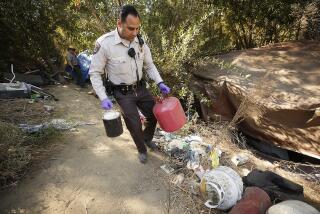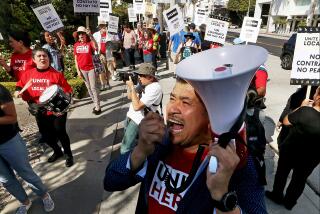Council Is Weighing Options on Leasing or Selling Airports : Finances: Members want to divert profits from LAX, three other fields for use throughout city. They ask officials for help on legal questions.
The Los Angeles City Council moved ahead Friday with efforts to bail out the financially strapped city treasury by diverting revenue from Los Angeles International Airport and three other city-run airports.
The council unanimously voted to ask city officials for advice on how to overcome legal obstacles to plans to lease or sell the airports, to sell surplus property at LAX or to use airport money for projects such as road repairs.
Council members, while still divided on how to proceed, said they hope the money can eventually be used to hire more police and firefighters, or for other basic city services. The city will freeze many expenditures in the fiscal year beginning July 1 to close a projected $183-million budget deficit.
“We need more careful analysis before deciding which way to go,” said Councilwoman Joy Picus. “But the message today is clearly that the airport needs to be more part of the city family.”
City officials have long rued the fact that while they considered cutting police, firefighters and other services, they could not take money from the financially flush Department of Airports.
Landing fees, concessions revenue and parking charges collected at Los Angeles, Van Nuys, Ontario and Palmdale airports can be spent only at the airports, under federal law and the City Charter.
The three measures approved by the council Friday seek to modify those legal restrictions.
The first, and most controversial, asks the city attorney’s office to report on how the charter would have to be changed to permit the sale or lease of any or all of the city-owned airports.
The council unanimously approved the study, although several members said they are unlikely to support the sale once the information is reported. “The people of the city bought the airport, they paid for it and it is theirs,” said Councilman Nate Holden. “This is just another gimmick.”
A consultant’s report last month found that the city could gain more money, about $3.4 billion over 30 years, by removing restrictions to use airport money in other parts of the city.
Leasing LAX would net almost as much, $3.2 billion, and would face fewer legal hurdles than simply trying to divert airport funds, according to a lawyer advising the city’s Airport Commission.
One firm that already operates several airports, Lockheed Air Terminal Inc., has been lobbying City Council members to clear the way for the lease or sale of the city-owned airports.
Viggo Butler, president of Lockheed Air, said his company initially had been interested only in leasing LAX but would consider leasing all four of the city’s airports.
City Councilwoman Ruth Galanter, who is leading the campaign to spend airport money throughout the city, said she prefers to keep the airport under city control.
She acknowledged that the Federal Aviation Administration and airlines are likely to fight any move to divert airport money to other city projects. “It’s clearly going to be an uphill fight to change the laws,” Galanter said, noting that other cities also are seeking more control over their airports. “But if all the cities around the country get involved, we will have a fighting chance.”
The second measure approved by the council Friday requests a report on how the city can remove legal obstacles that prevent it from taking title to surplus property near LAX.
The land is now in the hands of the Department of Airports.
Galanter says up to 340 acres on the north side of the airport could be leased or sold for small-scale development, possibly including a golf course, with profits going directly into the city treasury.
Finally, the council asked for a study of how the Department of Airports could bankroll more programs that are now paid out of the city’s General Fund, without changes in the charter or federal law.
The law now requires that airport money be spent only on “airport-related” expenses.
Galanter has argued that many more projects should fall under this heading--including the maintenance of thoroughfares such as Sepulveda and Century boulevards, which carry substantial traffic to and from LAX.
More to Read
Sign up for Essential California
The most important California stories and recommendations in your inbox every morning.
You may occasionally receive promotional content from the Los Angeles Times.











